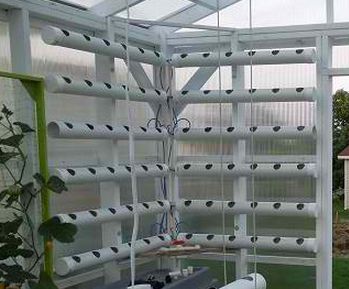When you don’t have enough room inside your home to garden year round, many people start considering the notion of putting up a greenhouse. Building it yourself is a lot more attractive than buying one of those kits, and you’ll find lots of DIY greenhouse projects crafted from recycled windows. Sounds cool, but you’ll have lots of problems with soaring temperatures in summer, maintaining warmth in winter, and the glass over-magnifying the sun. Then there is the problem of things like hail and high wind-borne objects breaking the glass.
Cheap kits are well, cheap – materials and construction. Flimsy and a poor investment, especially since the cheap ones really are not cheap at all. You’re really better off investing in materials to build your own greenhouse and harness the power of the sun.
 I came across a great set of plans for a 10-foot x 12-foot greenhouse that is fully automated and well designed, though in locations with bitter winters some customizing of the construction for passive solar heating will put you a step ahead of plummeting temperatures. The automation of hydroponic systems and environmental quality will be controlled on a network by Arduino. He’s used polycarbonate for better durability, and insulation. Yes, it’s more expensive than standard greenhouse poly covering, but it lasts longer and helps to make it more affordable to run your greenhouse. He should have done the north wall in solid material like wood and insulated it, but it’s his first greenhouse. It will no doubt get some modifications over time, and it’s a great start on an indoor garden that will produce a great deal of fresh food.
I came across a great set of plans for a 10-foot x 12-foot greenhouse that is fully automated and well designed, though in locations with bitter winters some customizing of the construction for passive solar heating will put you a step ahead of plummeting temperatures. The automation of hydroponic systems and environmental quality will be controlled on a network by Arduino. He’s used polycarbonate for better durability, and insulation. Yes, it’s more expensive than standard greenhouse poly covering, but it lasts longer and helps to make it more affordable to run your greenhouse. He should have done the north wall in solid material like wood and insulated it, but it’s his first greenhouse. It will no doubt get some modifications over time, and it’s a great start on an indoor garden that will produce a great deal of fresh food.
This is planned to house 112 plants – everything from tomatoes to lettuce and strawberries. By suspending the hydroponic units in the center of the roof framing he’s left plenty of room to start seedlings and even add some low growing plants beneath them in the middle of the area. And the corner unit vertical hydroponic system is set up to grow 72 plants in only 8 linear feet of wall space. Naturally, you could use this great space-saving hydro system inside your house too. It would fit just about anywhere, and if you house the reservoir inside an old cabinet could very easily be your garden in whatever room you have space to keep it growing food year around.
For plans and more info on building this great looking greenhouse, visit: http://www.instructables.com/id/The-Hydroponic-Automated-Networking-Climate-Con/
Want to know more about the vertical hydroponic systems? Visit: What is Vertical Gardening?
[/et_pb_text][/et_pb_column][/et_pb_row][/et_pb_section]
I want to know how much unit cost.what is the procedure if I want to make this system.